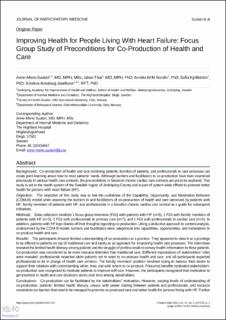| dc.contributor.author | Anne-Marie, Suutari | |
| dc.contributor.author | Thor, Johan | |
| dc.contributor.author | Nordin, Annika M.M. | |
| dc.contributor.author | Kjellström, Sofia | |
| dc.contributor.author | Areskoug Josefsson, Kristina | |
| dc.date.accessioned | 2024-04-16T07:10:41Z | |
| dc.date.available | 2024-04-16T07:10:41Z | |
| dc.date.created | 2021-05-12T13:36:07Z | |
| dc.date.issued | 2021 | |
| dc.identifier.citation | Journal of Participatory Medicine (JoPM). 2021, 13 (2), | en_US |
| dc.identifier.issn | 2152-7202 | |
| dc.identifier.uri | https://hdl.handle.net/11250/3126647 | |
| dc.description.abstract | Background: Co-production of health and care involving patients, families of patients, and professionals in care processes can create joint learning about how to meet patients’ needs. Although barriers and facilitators to co-production have been examined previously in various health care contexts, the preconditions in Swedish chronic cardiac care contexts are yet to be explored. This study is set in the health system of the Swedish region of Jönköping County and is part of system-wide efforts to promote better health for persons with heart failure (HF).
Objective: The objective of this study was to test the usefulness of the Capability, Opportunity, and Motivation Behavior (COM-B) model when assessing the barriers to and facilitators of co-production of health and care perceived by patients with HF, family members of patients with HF, and professionals in a Swedish chronic cardiac care context as a guide for subsequent initiatives.
Methods: Data collection involved 1 focus group interview (FGI) with patients with HF (n=5), 1 FGI with family members of patients with HF (n=5), 1 FGI with professionals in primary care (n=7), and 1 FGI with professionals in cardiac care (n=4). In addition, patients with HF kept diaries of their thoughts regarding co-production. Using a deductive approach to content analysis, underpinned by the COM-B model, barriers and facilitators were categorized into capabilities, opportunities, and motivations to co-produce health and care.
Results: The participants showed limited understanding of co-production as a practice. They appeared to view it as a privilege to be offered to patients on top of traditional care and rarely as an approach for improving health care processes. The interviews revealed the limited health literacy among patients and the struggle of professionals to convey health information to these patients. Co-production was considered to be more resource-intensive than traditional care. Different expectations of stakeholders’ roles were revealed: professionals expected older patients not to want to co-produce health and care, and all participants expected professionals to be in charge of health care services. The family members’ position involved trying to balance their desire to support their relatives with understanding when, how, and with whom to co-produce. Presumed benefits motivated stakeholders: co-production was recognized to motivate patients to improve self-care. However, the participants recognized that motivation to get involved in health and care decisions varies over time among stakeholders.
Conclusions: Co-production can be facilitated by the stakeholders’ motivation. However, varying levels of understanding of co-production, patients’ limited health literacy, unease with power sharing between patients and professionals, and resource constraints are barriers that need to be managed to promote co-produced care and better health for persons living with HF. Further research is warranted to explore how to co-produce health care services with patients with HF and how leaders can facilitate the inevitable cultural change it requires and represents. | en_US |
| dc.language.iso | eng | en_US |
| dc.publisher | JMRI Publications | en_US |
| dc.rights | Navngivelse 4.0 Internasjonal | * |
| dc.rights.uri | http://creativecommons.org/licenses/by/4.0/deed.no | * |
| dc.subject | co-production | en_US |
| dc.subject | cardiology | en_US |
| dc.subject | primary care | en_US |
| dc.subject | Sweden | en_US |
| dc.subject | heart failure | en_US |
| dc.subject | focus groups | en_US |
| dc.subject | opportunity, and motivation behavior model | en_US |
| dc.subject | capability | en_US |
| dc.subject | opportunity | en_US |
| dc.subject | motivation | en_US |
| dc.subject | capability | en_US |
| dc.subject | co-production of health and care | en_US |
| dc.title | Improving health for people living with heart failure: Focus group study of preconditions for co-production of health and care | en_US |
| dc.type | Peer reviewed | en_US |
| dc.type | Journal article | en_US |
| dc.description.version | publishedVersion | en_US |
| dc.rights.holder | ©Anne-Marie Suutari, Johan Thor, Annika M M Nordin, Sofia Kjellström, Kristina Areskoug Josefsson. Originally published in Journal of Participatory Medicine (https://jopm.jmir.org), 11.05.2021. | en_US |
| dc.source.pagenumber | 1-14 | en_US |
| dc.source.volume | 13 | en_US |
| dc.source.journal | Journal of Participatory Medicine (JoPM) | en_US |
| dc.source.issue | 2 | en_US |
| dc.identifier.doi | 10.2196/27125 | |
| dc.identifier.cristin | 1909715 | |
| cristin.ispublished | true | |
| cristin.fulltext | original | |
| cristin.qualitycode | 1 | |

